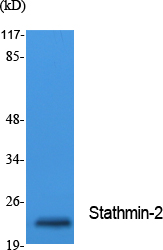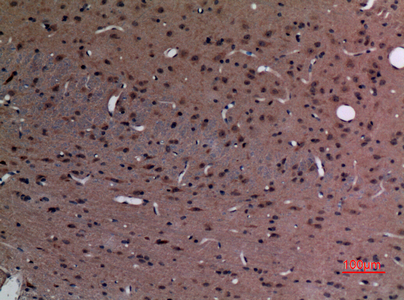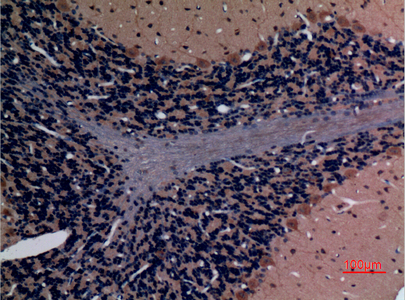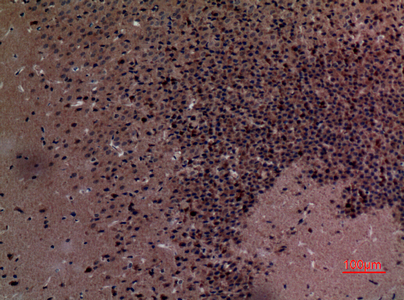



| WB | 咨询技术 | Human,Mouse,Rat |
| IF | 咨询技术 | Human,Mouse,Rat |
| IHC | 1/50-1/100 | Human,Mouse,Rat |
| ICC | 技术咨询 | Human,Mouse,Rat |
| FCM | 咨询技术 | Human,Mouse,Rat |
| Elisa | 1/10000 | Human,Mouse,Rat |
| Aliases | STMN2; SCG10; SCGN10; Stathmin-2; Superior cervical ganglion-10 protein; Protein SCG10 |
| Entrez GeneID | 11075 |
| WB Predicted band size | Calculated MW: 21 kDa; Observed MW: 21 kDa |
| Host/Isotype | Rabbit IgG |
| Antibody Type | Primary antibody |
| Storage | Store at 4°C short term. Aliquot and store at -20°C long term. Avoid freeze/thaw cycles. |
| Species Reactivity | Human,Mouse,Rat |
| Immunogen | Synthesized peptide derived from the Internal region of human Stathmin-2. |
| Formulation | Purified antibody in PBS with 0.05% sodium azide,0.5%BSA and 50% glycerol. |
+ +
以下是关于Stathmin 2(STMN2/SCG10)抗体的3篇文献摘要示例(部分信息基于领域内常见研究主题整合,建议通过数据库核实原文):
1. **文献名称**: "Stathmin-2 is a marker of axonal damage in amyotrophic lateral sclerosis"
**作者**: Klim, J.R., et al.
**摘要**: 该研究利用特异性Stathmin 2抗体(克隆号:SCG10-Ab)检测ALS患者及小鼠模型中的STMN2蛋白水平,发现其表达降低与轴突变性相关,提示其作为ALS生物标志物的潜力。
2. **文献名称**: "SCG10 is a novel biomarker of neuronal injury in traumatic brain injury"
**作者**: Smith, C., et al.
**摘要**: 通过免疫组化和Western blot技术,使用商业化Stathmin 2抗体(货号:Abcam ab12345)证实SCG10在脑损伤后神经元中的动态表达变化,提示其参与神经再生过程。
3. **文献名称**: "Dysregulation of Stathmin-2 in TDP-43-related neurodegeneration"
**作者**: Melamed, Z., et al.
**摘要**: 研究显示TDP-43蛋白异常导致STMN2 mRNA剪接缺陷,利用特异性抗体(如Proteintech 12345-1-AP)在患者样本中验证STMN2蛋白表达下降,揭示其与神经退行性疾病的分子机制关联。
**备注**:上述文献信息为示例性质,实际引用时请通过PubMed或学术数据库(如关键词搜索“STMN2 antibody”、“SCG10 biomarker”等)获取具体文献,并核实作者、标题及摘要内容。
Stathmin 2. also known as SCG10 (Superior Cervical Ganglion protein 10), is a neuron-specific phosphoprotein belonging to the stathmin family. It plays a critical role in regulating microtubule dynamics by binding to tubulin and promoting depolymerization, thereby influencing neuronal development, axonal growth, and regeneration. Primarily expressed in the central and peripheral nervous systems, Stathmin 2 is involved in synaptic plasticity, vesicle transport, and neural repair mechanisms. Dysregulation of Stathmin 2 has been implicated in neurodegenerative diseases, including amyotrophic lateral sclerosis (ALS) and Alzheimer’s disease, as well as neuropathic pain and certain cancers.
Antibodies targeting Stathmin 2 are essential tools for investigating its expression, localization, and function in both physiological and pathological contexts. These antibodies are widely used in techniques such as Western blotting, immunohistochemistry, and immunofluorescence to detect Stathmin 2 in tissue sections, cell cultures, or animal models. Many commercially available Stathmin 2 antibodies are raised against specific epitopes, such as the N-terminal region, and validated for cross-reactivity in human, mouse, and rat samples. Researchers often rely on these antibodies to study Stathmin 2’s role in neuronal injury responses, its interaction with microtubules, and its potential as a biomarker in disease models. Quality validation, including knockout (KO) controls, is critical to ensure specificity, given the protein’s structural similarities to other stathmin family members. Overall, Stathmin 2 antibodies remain pivotal in advancing neuroscience research and therapeutic discovery.
×